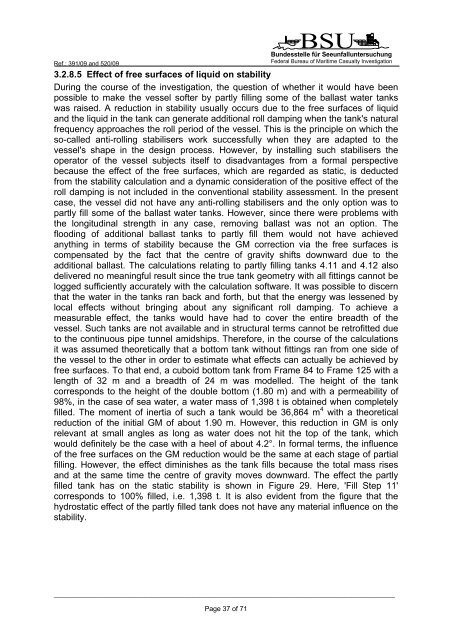SUB-COMMITTEE ON STABILITY AND LOAD LINES AND ON ...
SUB-COMMITTEE ON STABILITY AND LOAD LINES AND ON ...
SUB-COMMITTEE ON STABILITY AND LOAD LINES AND ON ...
Create successful ePaper yourself
Turn your PDF publications into a flip-book with our unique Google optimized e-Paper software.
Ref.: 391/09 and 520/09<br />
BSU<br />
Bundesstelle für Seeunfalluntersuchung<br />
Federal Bureau of Maritime Casualty Investigation<br />
3.2.8.5 Effect of free surfaces of liquid on stability<br />
During the course of the investigation, the question of whether it would have been<br />
possible to make the vessel softer by partly filling some of the ballast water tanks<br />
was raised. A reduction in stability usually occurs due to the free surfaces of liquid<br />
and the liquid in the tank can generate additional roll damping when the tank's natural<br />
frequency approaches the roll period of the vessel. This is the principle on which the<br />
so-called anti-rolling stabilisers work successfully when they are adapted to the<br />
vessel's shape in the design process. However, by installing such stabilisers the<br />
operator of the vessel subjects itself to disadvantages from a formal perspective<br />
because the effect of the free surfaces, which are regarded as static, is deducted<br />
from the stability calculation and a dynamic consideration of the positive effect of the<br />
roll damping is not included in the conventional stability assessment. In the present<br />
case, the vessel did not have any anti-rolling stabilisers and the only option was to<br />
partly fill some of the ballast water tanks. However, since there were problems with<br />
the longitudinal strength in any case, removing ballast was not an option. The<br />
flooding of additional ballast tanks to partly fill them would not have achieved<br />
anything in terms of stability because the GM correction via the free surfaces is<br />
compensated by the fact that the centre of gravity shifts downward due to the<br />
additional ballast. The calculations relating to partly filling tanks 4.11 and 4.12 also<br />
delivered no meaningful result since the true tank geometry with all fittings cannot be<br />
logged sufficiently accurately with the calculation software. It was possible to discern<br />
that the water in the tanks ran back and forth, but that the energy was lessened by<br />
local effects without bringing about any significant roll damping. To achieve a<br />
measurable effect, the tanks would have had to cover the entire breadth of the<br />
vessel. Such tanks are not available and in structural terms cannot be retrofitted due<br />
to the continuous pipe tunnel amidships. Therefore, in the course of the calculations<br />
it was assumed theoretically that a bottom tank without fittings ran from one side of<br />
the vessel to the other in order to estimate what effects can actually be achieved by<br />
free surfaces. To that end, a cuboid bottom tank from Frame 84 to Frame 125 with a<br />
length of 32 m and a breadth of 24 m was modelled. The height of the tank<br />
corresponds to the height of the double bottom (1.80 m) and with a permeability of<br />
98%, in the case of sea water, a water mass of 1,398 t is obtained when completely<br />
filled. The moment of inertia of such a tank would be 36,864 m 4 with a theoretical<br />
reduction of the initial GM of about 1.90 m. However, this reduction in GM is only<br />
relevant at small angles as long as water does not hit the top of the tank, which<br />
would definitely be the case with a heel of about 4.2°. In formal terms, the influence<br />
of the free surfaces on the GM reduction would be the same at each stage of partial<br />
filling. However, the effect diminishes as the tank fills because the total mass rises<br />
and at the same time the centre of gravity moves downward. The effect the partly<br />
filled tank has on the static stability is shown in Figure 29. Here, 'Fill Step 11'<br />
corresponds to 100% filled, i.e. 1,398 t. It is also evident from the figure that the<br />
hydrostatic effect of the partly filled tank does not have any material influence on the<br />
stability.<br />
_____________________________________________________________________________________________________<br />
Page 37 of 71
















